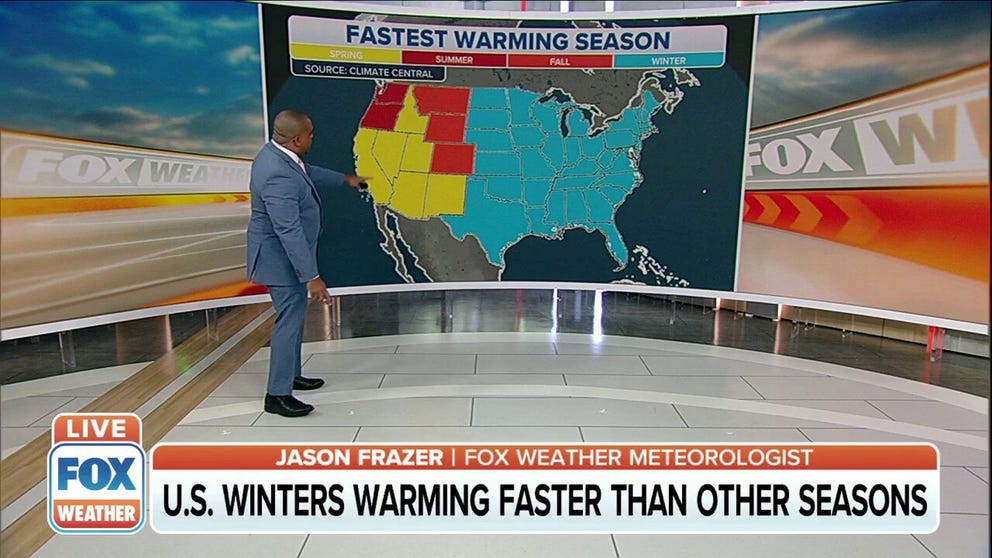Studies find winter is fastest-warming season in US
Winter was the fastest-warming season for 74% of the US locations analyzed in a recent study. While these locations were found from coast to coast, they were most widespread in the eastern half of the country between the Plains and the East Coast.
U.S. winters are warming faster than any other season
Winters in the U.S. are warming faster than any other season, a pair of studies has found.
Winters in the U.S. are warming faster than any other season, a pair of studies has found. But even though temperatures might be more tolerable, it's actually bad news for a number of reasons.
A study recently updated in mid-November by independent research group Climate Central showed that average temperatures since 1970 increased more in the winter than any other season in nearly three-quarters (74%) of the nation. Winter is defined as the three-month period from December through February.
Winter was the fastest-warming season for 182 of the 246 U.S. locations analyzed by Climate Central. While these locations were found from coast to coast, they were most widespread in the eastern half of the country between the Plains and the East Coast.
In particular, the Northeast and the Great Lakes region had the greatest number of locations that warmed faster in winter than any other season.
NOAA FINDS 'SMALL BUT NOTICEABLE SHIFT' IN COLDEST TIME OF YEAR FOR EASTERN U.S.
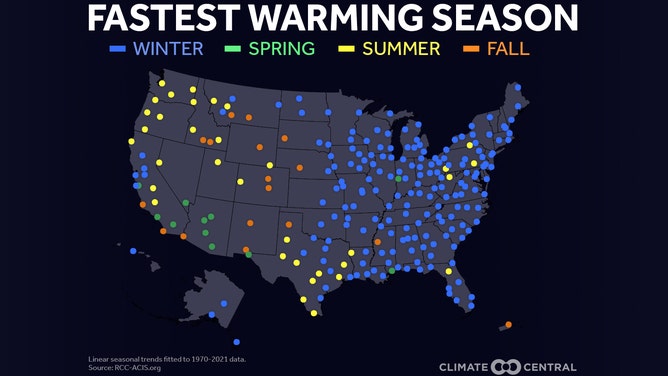
Each color depicts which season has warmed the fastest since 1970. Winter is the fastest-warming season for the 182 locations shaded in blue.
(Map: Climate Central; Data: NOAA/NCEI)
A second study published last year by Climate Central drew a very similar conclusion, noting that the region from the Great Lakes to the Northeast experienced the largest increase in average winter temperatures since 1970.
The five cities with the greatest increase in winter temperatures were Burlington, Vermont (7.2 degrees), Concord, New Hampshire (6 degrees), Milwaukee (6 degrees), Chattanooga, Tennessee (5.8 degrees), and Green Bay, Wisconsin (5.8 degrees).
CLIMATE TIPPING POINTS COULD BE REACHED EVEN IF WARMING IS LIMITED TO CURRENT GOALS, STUDY FINDS
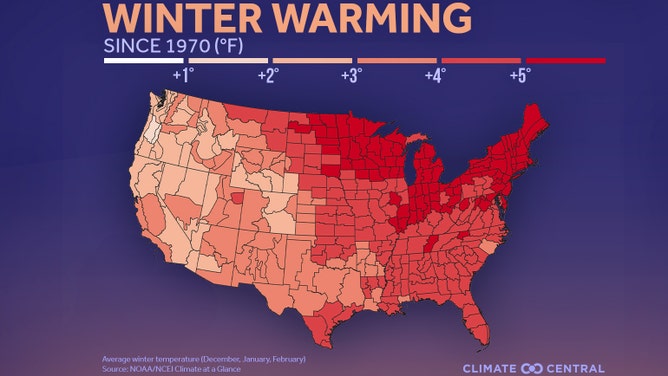
This map analyzes the magnitude of warming during the winter months (December-February) using 52 years of temperature data (1970-2021).
(Map: Climate Central; Data: NOAA/NCEI)
Climate Central also found nearly three-quarters (183) of the 246 locations analyzed in 2021 had at least seven more winter days with above-average temperatures than in 1970.
Philadelphia has 18 more winter days that are warmer than the 1991-2020 average when compared to 1970, while Phoenix has 17 more such days and Houston has 11 more.
NOAA PUMPING $15 MILLION INTO CLIMATE CHANGE RESEARCH AND IMPROVING RESILIENCE
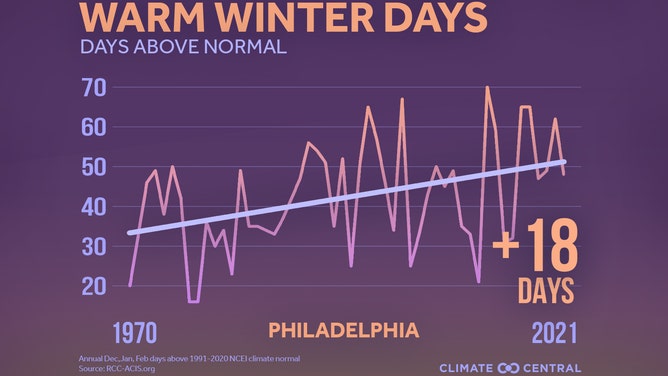
Philadelphia has 18 more winter (December-February) days that are warmer than the 1991-2020 average when compared to 1970.
(Graph: Climate Central; Data: NOAA/NCEI)
Many locations in the western U.S. recorded their largest increase in average temperature during the spring and fall, while some locations in Washington, Oregon, Texas and Florida saw summers warm most quickly, according to the pair of studies.
But for the remainder of the country, winter is warming faster than the other three seasons, and that's not necessarily a good thing.
DECEMBER WINTER WEATHER OUTLOOK: COLD AIR TO WIN OUT OVER NORTHERN U.S.
"Warming winters may sound great at first, but they can have negative impacts on our health and regional economies," Climate Central said in last year's study. These negative impacts include:
- Reduced water supply: The West relies on a melting snowpack in the spring to help refill reservoir levels and irrigate crops ahead of the summer dry season. Warmer winter temperatures would likely disrupt snowfall patterns, potentially resulting in a reduced snowpack to replenish the region's water supply.
- Financial troubles for regional economies: Regional economies and cultures that depend on winter recreation could suffer a financial loss. Winter recreation is a billion-dollar industry, so without enough snow and ice for a long season of skiing, ice fishing or snowmobiling, the industry could take a substantial economic hit.
- Lower fruit production: Cold winter temperatures are required for cherry, apple and peach trees in order for them to develop fruit in the subsequent spring and summer months. Warmer winters could eventually limit fruit development if there is a lack of sufficiently cold weather for adequate fruit production.
- Increased summer cooling demand: Although warmer winters can reduce energy demands for home heating – which might seem like good news with the rising costs of natural gas, propane and heating oil – those savings could be offset by increased cooling demands during the summer, which is also growing warmer due to climate change.
FEELING THE HEAT: HOME ENERGY COSTS SPIKE WELL BEYOND PREDICTED JUMPS THIS WINTER
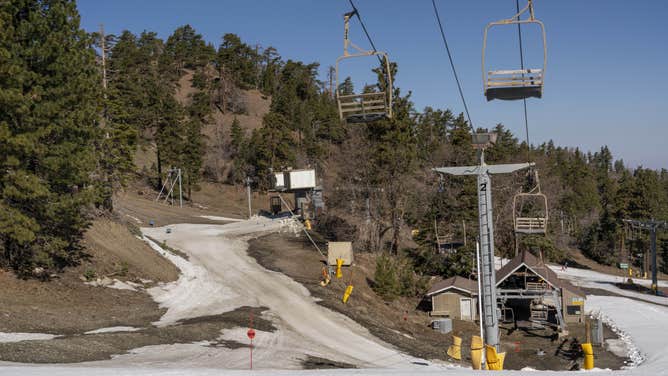
Snow melts around chair lifts at Mountain High Resort in Wrightwood, California, on April 6, 2022.
(Kyle Grillot / Bloomberg / Getty Images)
Although the long-term trend for most of the U.S. is an increase in wintertime temperatures, you can see from the Philadelphia temperature graph above that there are year-to-year fluctuations, so some winters will be warmer while others will be colder.
"There can still be cold winters under climate change," Climate Central said in last year's study. "The likelihood of extreme cold conditions in a warming world is decreasing, but it is not zero. Some locations will still experience extreme cold or cold records – just not as cold or for as long as in the past."
